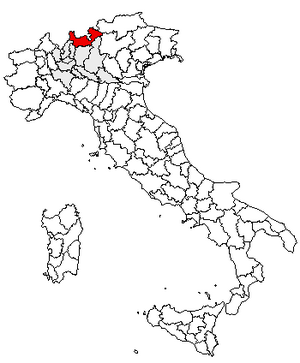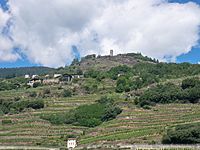Province of Sondrio facts for kids
Quick facts for kids
Province of Sondrio
Sondrio
|
|
|---|---|
 |
|
| Country | |
| Region | Lombardy |
| Capital | Sondrio |
| Area | |
| • Total | 3,212 km2 (1,240 sq mi) |
| Population
(2001)
|
|
| • Total | 176,769 |
| • Density | 55/km2 (140/sq mi) |
| Telephone prefix |
0342, 0343
|
| ISTAT | 014 |
| Vehicle registration | SO |
| No. of communes | 78 |

The Province of Sondrio (Italian: provincia di Sondrio) is a special part of northern Italy. It's located in the Lombardy region. The main city and capital of this province is Sondrio. As of 2017, about 181,403 people live here.
History of Sondrio Province
How the Province Was Formed
The Province of Sondrio was created in 1815. This happened when it became part of the Kingdom of Lombardy–Venetia. This new province brought together three important valleys: Valtellina, Valchiavenna, and Bormio.
Ancient Times and Roman Rule
Long ago, before the Romans arrived, different groups of people lived here. These included the Celts (also called Lepontii) and the Rhaetians (Camunni). When the Romans took over, they made this area part of their province called Cisalpine Gaul.
From Feudal Lords to Milanese Rule
After the Western Roman Empire ended, a Germanic tribe called the Lombards settled in the area. At first, local lords ruled the land. Later, the powerful House of Visconti and House of Sforza families took control. They ruled from the Duchy of Milan.
Sondrio's Importance in Europe
Sondrio and the Valtellina valley were very important in European politics. This was especially true during the religious wars of the 16th and 17th centuries. The area had key connections to other parts of Europe through passes like the Spluga Pass. These routes were used to move troops and goods.
Swiss and Spanish Control
When the Duchy of Milan became weaker, the Swiss Canton of Graubünden took control of Sondrio. However, in 1622, the Spanish Governor of Milan invaded Valtellina. The Spanish wanted to use the valleys to move their soldiers around Europe. A local revolt in Valtellina against the Swiss in 1620 helped the Spanish efforts.
Peace and New Republics
The Peace of Westphalia in 1648 brought peace to the region. It also gave the area back to the Canton of Graubünden. Later, in 1797, the Republic of Valtellina was formed. But it was soon taken over by the French. It became part of a French-controlled state called the Cisalpine Republic.
Joining Italy
In 1815, the Congress of Vienna decided that Sondrio and Valtellina would become a province of the Austrian Kingdom of Lombardy–Venetia. Finally, in 1866, Lombardy–Venetia joined the Kingdom of Italy.
Geography of Sondrio Province
Mountains and Valleys
The Province of Sondrio is mostly a mountainous area. It doesn't have many people living there. It's in the northern part of Lombardy. To the north, it borders the Swiss canton of Graubünden. To the west, it borders the Provinces of Como and Lecco. The Province of Bergamo is to the south. To the east are the Provinces of Brescia, Trento, and Bolzano. The Rhaetian Alps are the highest mountains in the Lombardy region.
Most of the valleys in Sondrio run from north to south. The two main ones are the Valtellina and Valchiavenna.
Towns and Natural Parks
One of the well-known towns is Livigno. It's about 1,800 meters (5,900 feet) above sea level. Livigno is a popular place for tourists in the summer and a great ski resort in the winter. The province has 78 different towns and villages, called communes. Sondrio is the biggest town and the main administrative center. The Stelvio National Park is a beautiful natural area located in the northeastern part of the province.
Economy and Farming
The economy of Sondrio Province is based on several activities. These include construction, cutting down trees (logging), getting stones from quarries, tourism, and light industry. Some workers from Switzerland travel to Sondrio for work. Also, some people from Italy cross the border to work in Switzerland.
Growing grapes has been a long tradition throughout the province. Each area has its own type of grape and makes its own local wine. Farmers have built special terraces on the steep hillsides. They use dry stone walls to hold the earth in place. This helps them use land that would otherwise be too difficult for farming. The traditions of viticulture (grape growing and winemaking) are a very important part of the local culture.
Images for kids
-
Terraced fields in Valtellina.
See also
 In Spanish: Provincia de Sondrio para niños
In Spanish: Provincia de Sondrio para niños


